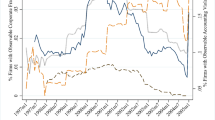Abstract
In this paper, we present experimental evidence on the effect adverse selection has on coverage choices and pricing in corporate insurance markets. Two sets of experimental data, each generated by experiments utilizing a specific parameterization of a corporate insurance decision, are presented to gauge these effects. In the first, subject behavior conforms to a unique equilibrium in which high risk firms choose higher coverage and contracts are priced accordingly. Insurers act competitively and convergence to equilibrium behavior is marked. In the second set, there is little evidence that subject behavior is consistent with either of the two equilibrium outcomes supported by the experimental setting—pooling by fully insuring losses and pooling by self insuring.
Similar content being viewed by others
References
Banks, J., & Sobel, J. (1987). Equilibrium selection in signaling games. Econometrica, 55, 647–662.
Banks, J., Camerer, C., & Porter, D. (1994). An experimental analysis of nash refinements in signaling games. Games and Economic Behavior, 6, 1–31.
Best’s Aggregates and Averages Property and Casualty (1995). Oldwick: NJ.
Bond, E., & Crocker, K. (1991). Smoking, skydiving, and knitting: The endogenous categorization of risks in insurance markets with asymmetric information. Journal of Political Economy, 99, 177–200.
Brandts, J., & Holt, C. (1992). An experimental test of equilibrium dominance in signaling games. American Economic Review, 82, 1350–1365.
Brandts, J., & Holt, C. (1993). Adjustment patterns and equilibrium selection in experimental signaling games. International Journal of Game Theory, 22, 279–302.
Browne, M. (1993). Evidence on adverse selection in the individual health insurance market. Journal of Risk and Insurance, 60, 300–312.
Cadsby, C., Frank, M., & Maksimovic, V. (1998). Equilibrium dominance in experimental financial markets. Review of Financial Studies, 11(1), 189–232.
Cadsby, C., Frank, M., & Maksimovic, V. (1990). Pooling, separating, and semiseparating equilibria in financial markets: Some experimental evidence. Review of Financial Studies, 3, 315–342.
Chiappori, P.-A., & Salanie, B. (2001). Testing for asymmetric information in insurance markets. Journal of Political Economy, 108, 56–78.
Cho, I. K., & Sobel, J. (1990). Strategic stability and uniqueness in signaling games. Journal of Economic Theory, 50, 381–413.
Dionne, G., & Doherty, N. (1991). Adverse selection in insurance markets: A selective survey. In G. Dinne (ed.), Contributions to insurance economics. Boston, MA: Kluwer.
Fudenberg, D., & Tirole, J. (1991). Game theory. Cambridge, MA: MIT.
Holt, C., & Sherman, R. (1994). The Loser’s curse and bidder bias. American Economic Review, 84, 642–652.
Myers, S., & Majluf, N. (1984). Corporate financing and investment decisions when firms have information investors do not have. Journal of Financial Economics, 13, 187–221.
Puelz, R., & Snow, A. (1994). Evidence on adverse selection: Equilibrium signaling and cross-subsidization in the insurance market. Journal of Political Economy, 102, 236–257.
Rebello, M. J., & Martin Grace (1993). Financing and demand for corporate insurance: A sequential signaling game. Geneva Papers on Risk and Insurance Theory, 18, 147–172.
Rothschild, M., & Stiglitz, J. (1976). Equilibrium in insurance markets: An essay on the economics of imperfect information. Quarterly Journal of Economics, 90, 629–649.
Teach, E. (1996). The rise of the alternate market, and a feeding frenzy in the conventional insurance market. CFO, 12(9), 59.
Thakor, A. (1982). An exploration of competitive signaling equilibria with ‘third party’ information production: The case of debt insurance. Journal of Finance, 37, 717–739.
Author information
Authors and Affiliations
Additional information
JEL Classification C90, G14, G22
Electronic Supplementary Material Supplementary material is available in the online version of this article at http://dx.doi.org/10.1007/s10683-006-9152-y.
Rights and permissions
About this article
Cite this article
Goswami, G., Grace, M.F. & Rebello, M.J. Experimental evidence on coverage choices and contract prices in the market for corporate insurance. Exp Econ 11, 67–95 (2008). https://doi.org/10.1007/s10683-006-9152-y
Received:
Revised:
Accepted:
Published:
Issue Date:
DOI: https://doi.org/10.1007/s10683-006-9152-y




